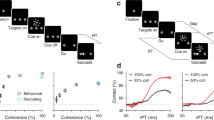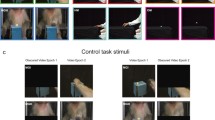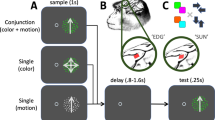Abstract
Goal-directed behavior is characterized by flexible stimulus-action mappings. The lateral intraparietal area (area LIP) contains a representation of extra-personal space that is used to guide goal-directed behavior. To examine further how area LIP contributes to these flexible stimulus-action mappings, we recorded LIP activity while rhesus monkeys participated in two different cueing tasks. In the first task, the color of a central light indicated the location of a monkey’s saccadic endpoint in the absence of any other visual stimuli. In the second task, the color of a central light indicated which of two visual targets was the saccadic goal. In both tasks, LIP activity was modulated by these non-spatial cues. These observations further suggest a role for area LIP in mediating endogenous associations that link stimuli with actions.










Similar content being viewed by others
References
Andersen RA (1987) Inferior parietal lobule function in spatial perception and visuomotor integration. In: Plum F, Mountcastle VM, Geirger SR (eds) The handbook of physiology, Sect. 1: the nervous system, vol. V. Higher functions of the brain, vol V. American Physiological Society, Bethesda, pp 483–518
Andersen RA, Asanuma C, Essick G, Siegel RM (1990) Corticocortical connections of anatomically and physiologically defined subdivisions within the inferior parietal lobule. J Comp Neurol 296:65–113
Andersen RA, Buneo CA (2002) Intentional maps in posterior parietal cortex. Annu Rev Neurosci 25:189–220
Andersen RA, Snyder LH, Bradley DC, Xing J (1997) Multimodal representation of space in the posterior parietal cortex and its use in planning movements. Annu Rev Neurosci 20:303–330
Assad JA (2003) Neural coding of behavioral relevance in parietal cortex. Curr Opin Neurobiol 13:194–197
Barash S, Bracewell RM, Fogassi L, Gnadt JW, Andersen RA (1991a) Saccade-related activity in the lateral intraparietal area. I. Temporal properties; comparison with area 7a. J Neurophysiol 66:1095–1108
Barash S, Bracewell RM, Fogassi L, Gnadt JW, Andersen RA (1991b) Saccade-related activity in the lateral intraparietal area. II. Spatial properties. J Neurophysiol 66:1109–1124
Becker W, Fuchs AF (1969) Further properties of the human saccadic system: eye movements and correction saccades with and without visual fixation points. Vis Res 9:1247–1258
Bisley JW, Goldberg ME (2003) Neuronal activity in the lateral intraparietal area and spatial attention. Science 299:81–86
Bushnell MC, Goldberg ME, Robinson DL (1981) Behavioral enhancement of visual responses in monkey cerebral cortex. I. Modulation in posterior parietal cortex related to selective visual attention. J Neurophysiol 46:755–772
Calton JL, Dickinson AR, Snyder LH (2002) Non-spatial, motor-specific activation in posterior parietal cortex. Nat Neurosci 5:580–588
Cohen YE, Andersen RA (2002) A common reference frame for movement plans in the posterior parietal cortex. Nat Rev Neurosci 3:553–562
Cohen YE, Batista AP, Andersen RA (2002) Comparison of neural activity preceding reaches to auditory and visual stimuli in the parietal reach region. Neuroreport 13:891–894
Cohen YE, Cohen IS, Gifford III GW (2004a) Modulation of LIP activity by predictive auditory and visual cues. Cereb Cortex 14:1287–1301
Cohen YE, Russ BE, Gifford III GW, Kiringoda R, MacLean KA (2004b) Selectivity for the spatial and nonspatial attributes of auditory stimuli in the ventrolateral prefrontal cortex. J Neurosci 24:11307–11316
Cover TM, Thomas JA (1991) Elements of information theory. Wiley, New York
Critchley M (1966) The parietal lobes. Hafner Publishing Co., New York
Dickinson AR, Calton JL, Snyder LH (2003) Nonspatial saccade-specific activation in area LIP of monkey parietal cortex. J Neurophysiol 90:2460–2464
Egeth HE, Yantis S (1997) Visual attention: control, representation, and time course. Annu Rev Psychol 48:269–297
Gifford III GW, Cohen YE (2004) The effect of a central fixation light on auditory spatial responses in area LIP. J Neurophysiol 91:2929–2933
Gifford III GW, Cohen YE (2005) Spatial and non-spatial auditory processing in the lateral intraparietal area. Exp Brain Res 162:509–512
Gnadt JW, Andersen RA (1988) Memory related motor planning activity in posterior parietal cortex of macaque. Exp Brain Res 70:216–220
Goldberg ME, Bisley J, Powell KD, Gottlieb J, Kusunoki M (2002) The role of the lateral intraparietal area of the monkey in the generation of saccades and visuospatial attention. Ann N Y Acad Sci 956:205–215
Gottlieb J, Goldberg ME (1999) Activity of neurons in the lateral intraparietal area of the monkey during an antisaccade task. Nat Neurosci 2:906–912
Gottlieb JP, Kusunoki M, Goldberg ME (1998) The representation of visual salience in monkey parietal cortex. Nature 391:481–484
Groh JM, Trause AS, Underhill AM, Clark KR, Inati S (2001) Eye position influences auditory responses in primate inferior colliculus. Neuron 29:509–518
Grunewald A, Linden JF, Andersen RA (1999) Responses to auditory stimuli in macaque lateral intraparietal area. I. Effects of training. J Neurophysiol 82:330–342
Hyvärinen J (1982) Posterior parietal lobule of the primate brain. Physiol Rev 62:1060–1129
Judge SJ, Richmond BJ, Chu FC (1980) Implantation of magnetic search coils for measurement of eye position: an improved method. Vis Res 20:535–538
Kusunoki M, Gottlieb J, Goldberg ME (2000a) The lateral intraparietal area as a salience map: the representation of abrupt onset, stimulus motion, and task relevance. Vis Res 40:1459–1468
Kusunoki M, Gottlieb J, Goldberg ME (2000b) The lateral intraparietal area as a salience map: the representation of abrupt onset, stimulus motion, and task relevance. Vis Res 40:1459–1468
LaBerge D (1995) Attentional processing: the brain’s art of mindfulness. Harvard University Press, Cambridge
Lewis JW, Van Essen DC (2000) Corticocortical connections of visual, sensorimotor, and multimodal processing areas in the parietal lobe of the macaque monkey. J Comp Neurol 428:112–137
Linden JF, Grunewald A, Andersen RA (1999) Responses to auditory stimuli in macaque lateral intraparietal area. II. Behavioral modulation. J Neurophysiol 82:343–358
Mountcastle VB, Lynch JC, Georgopoulos A, Sakata H, Acuna C (1975) Posterior parietal association cortex of the monkey: command functions for operations within extrapersonal space. J Neurophysiol 38:871–908
Nieder A, Miller EK (2004) A parieto-frontal network for visual numerical information in the monkey. Proc Natl Acad Sci USA 101:7457–7462
Panzeri S, Treves A (1996) Analytical estimates of limited sampling biases in different information measures. Network 7:87–107
Platt ML, Glimcher PW (1997) Responses of intraparietal neurons to saccadic targets and visual distractors. J Neurophysiol 78:1574–1589
Platt ML, Glimcher PW (1998) Response fields of intraparietal neurons quantified with multiple saccadic targets. Exp Brain Res 121:65–75
Platt ML, Glimcher PW (1999) Neural correlates of decision variables in parietal cortex. Nature 400:233–238
Posner MI (1980) Orienting of attention. Q J Exp Psychol 32:3–25
Powell KD, Goldberg ME (2000) Response of neurons in the lateral intraparietal area to a distractor flashed during the delay period of a memory-guided saccade. J Neurophysiol 84:301–310
Robinson DL, Bowman EM, Kertzman C (1995) Covert orienting of attention in macaques. II. Contributions of parietal cortex. J Neurophysiol 74:698–712
Sawamura H, Shima K, Tanji J (2002) Numerical representation for action in the parietal cortex of the monkey. Nature 415:918–922
Sereno AB, Maunsell JH (1998) Shape selectivity in primate lateral intraparietal cortex. Nature 395:500–503
Shadlen MN, Newsome WT (1996) Motion perception: seeing and deciding. Proc Natl Acad Sci USA 93:628–633
Shadlen MN, Newsome WT (2001) Neural basis of a perceptual decision in the parietal cortex (area LIP) of the rhesus monkey. J Neurophysiol 86:1916–1936
Shannon CE (1948a) A mathematical theory of communication. Bell Syst Techn J 27:379–423
Shannon CE (1948b) A mathematical theory of communication. Bell Syst Techn J 27:623–656
Snyder LH (2000) Coordinate transformations for eye and arm movements in the brain. Curr Opin Neurobiol 10:747–754
Snyder LH, Batista AP, Andersen RA (1997) Coding of intention in the posterior parietal cortex. Nature 386:167–170
Snyder LH, Batista AP, Andersen RA (2000) Intention-related activity in the posterior parietal cortex: a review. Vis Res 40:1433–1441
Snyder LH, Calton JL, Dickinson AR, Lawrence BM (2002) Eye-hand coordination: saccades are faster when accompanied by a coordinated arm movement. J Neurophysiol 87:2279–2286
Stoet G, Snyder LH (2004) Single neurons in posterior parietal cortex of monkeys encode cognitive set. Neuron 42:1003–1012
Sugrue LP, Corrado GS, Newsome WT (2004) Matching behavior and the representation of value in the parietal cortex. Science 304:1782–1787
Thompson RF, Mayers KS, Robertson RT, Patterson CJ (1970) Number coding in association cortex of the cat. Science 168:271–273
Toth LJ, Assad JA (2002) Dynamic coding of behaviourally relevant stimuli in parietal cortex. Nature 415:165–168
Zambarbieri D, Beltrami G, Versino M (1995) Saccade latency toward auditory targets depends on the relative position of the sound source with respect to the eyes. Vis Res 35:3305–3312
Zambarbieri D, Schmid R, Magenes G, Prablanc C (1982) Saccadic responses evoked by presentation of visual and auditory targets. Exp Brain Res 47:417–427
Acknowledgements
We thank K. Strayer-Benton for help with data collection, K. MacLean for help with training and data collection, L. Snyder and H. Hersh for helpful discussions and comments on previous versions of the manuscript, T. Laroche for assistance with MRI, and A. Underhill for her exceptional technical support. YEC was supported by grants from the Whitehall Foundation, NIH, and a Burke Award.
Author information
Authors and Affiliations
Corresponding author
Rights and permissions
About this article
Cite this article
Russ, B.E., Kim, A.M., Abrahamsen, K.L. et al. Responses of neurons in the lateral intraparietal area to central visual cues. Exp Brain Res 174, 712–727 (2006). https://doi.org/10.1007/s00221-006-0514-7
Received:
Accepted:
Published:
Issue Date:
DOI: https://doi.org/10.1007/s00221-006-0514-7




